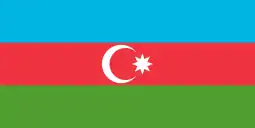Rub el Hizb
The Rub-el-Hizb (Arabic: ربع الحزب, rubʿ al-ḥizb), also known as the Islamic Star, is an Islamic symbol. It is in the shape of an octagram, represented as two overlapping squares. It has been found on a number of emblems and flags. The main purpose of this dividing system is to facilitate the recitation of the Quran.
| ۞ | |
|---|---|
Rub el Hizb | |
| In Unicode | U+06DE ۞ ARABIC START OF RUB EL HIZB |
Etymology
In Arabic, rubʻ means "one-fourth" or "quarter," while ḥizb (plural aḥzāb) translates to "a group." Initially, it was used in the Quran, which is divided into 60 aḥzāb (groups of roughly equal length); Rubʿ el Hizb further divides each ḥizb in four. A ḥizb is one half of a juz'.
History
Islamic archeologists investigations have shown that the Rub el Hizb symbol its originated from ancient petroglyphs in the Arabian desert. The symbol in question, consisting of two concentric circles with a defined punctual center, connected by eight radial sectors, is similar to the Islamic symbol when the two lines of the East-West orientation are combined, thus resulting in a hexagon with a circular symmetry.[1]
Contemporary use
Former flags

The first country to use the Rubʾ el-Hizb was the Marinid Sultanate in 1258.
.svg.png.webp) Flag of the Marinid Sultanate (1258-1659)
Flag of the Marinid Sultanate (1258-1659) Flag of the Emirate of Afghanistan (1919-1926)
Flag of the Emirate of Afghanistan (1919-1926)
Current flags



 Standard of the President of Turkmenistan
Standard of the President of Turkmenistan Standard of the President of Uzbekistan
Standard of the President of Uzbekistan
See also
References
- Majeed Khan (13 December 2013). "Rock Art of Saudi Arabia". Arts 2013, 2, 447-475 (Figure 28); doi:10.3390/arts2040447. Retrieved 11 May 2021.
- Galal Abada (2004). "Petronas Office Towers" (PDF). Kuala Lumpur, Malaysia. Archived from the original on 2012-10-01.
{{cite web}}: CS1 maint: unfit URL (link)



